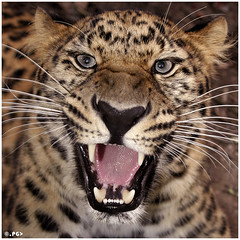Amur Leopard
Edgar Thissen comes to the MagicDonkey group from Rotterdam, The Netherlands. While he is a new associate of mine in the craft of photography, his pictures portray a quality that is seldom equalled. His compositions are excellent, and many center on nature and landscapes. But he does not limit himself, throughout his photo stream can be found wonderful portraits, and spectacular creative efforts.
His photo Amur Leopard was recently promoted to the 25 percent MagicDonkey Solution and we are honored to have this best of the best photographs in that exclusive pool.
From Edgar Thissen's commentary:
The Amur leopard (Panthera pardus orientalis), whose habitat is currently confined to the Sikhote-Alin mountains, is the northernmost subspecies of leopard. It is also known as the Far-East leopard and the Siberian leopard. It is extremely close to extinction, with only about 35 still living in the wild. Habitat destruction and the fur trade have diminished its numbers dramatically.
Although their range overlaps with that of the Siberian tiger, their population is not as heavily affected as it is for other leopards and tigers in different regions. Amur leopards tend to avoid living or hunting too close to tiger territory to avoid direct competition for prey.
Like all leopards, they are very skillful and opportunistic hunters, though their usual diet consists of roe and sika deer, hares, badgers and smaller rodents. They are solitary animals with primarily nocturnal habits.
They stand apart from other leopards in their longer fur and legs, probably to better cope in the harsh, cold conditions of the taiga. They also have larger and more widely spaced rosettes. Their fur lightens to a pale cream during winter, but is more golden orange during summer. During the summer, their fur is usually about 2.5 cm long, but during winter, their fur is around 7 cm. Males are about fifty percent larger than females, and their weight ranges from 65 to 155 pounds.
While the Amur leopard inhabits the same area as the Siberian tiger, it has received far less attention from the media and from charities. The Amur leopard is the rarest of the big cats, and is in danger of dying out in the wild. They are suffering from habitat loss and are especially vulnerable to natural disasters, such as fire, because of their fragmented range. Amur leopards prefer to live in forested territory, but most of the forest in which they live is surrounded by farms and villages, making poaching easier.
from: Wikipedia
Taken @ Blijdorp Zoo, Rotterdam
To go to Edgar Thissen's photostream.
To see a slideshow of the best of Flickr.
To go to the home of MagicDonkey



0 Comments:
Post a Comment
<< Home